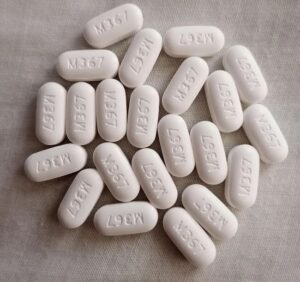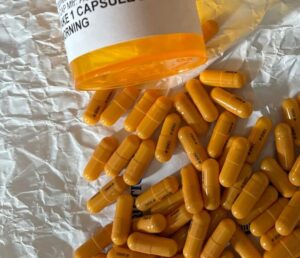Factors Influencing How Long Does Adderall Stay In Your System
Adderall gets absorbed in the gastrointestinal tract and is either deactivated by the liver or excreted unchanged in urine. Approximately 20-25% of it changes into metabolites, such as hippuric and benzoic acids.
The elimination speed of Adderall is directly affected by the urine’s pH. A lower urine pH means quicker drug elimination, whereas a higher pH slows down the process.
Dosage, Frequency, and Formulations
The amount and frequency of Adderall intake significantly influence how long it remains detectable in the body. Higher doses and more frequent usage extend the detection period. The drug’s formulation, whether immediate-release or extended-release, also impacts its duration in the system.
Individual Metabolic Rate and its Effects
Metabolism varies from person to person, affecting how quickly Adderall is processed and eliminated. Factors like genetics, body composition, physical activity, and overall health play a role in this variation. For instance, regular exercise might result in a faster metabolism, leading to quicker Adderall elimination.
Impact of Age and Health Conditions
Younger individuals typically metabolize Adderall faster than older adults, resulting in a shorter detection time. Additionally, health conditions, especially those affecting the liver or kidneys, can slow down drug metabolism, prolonging the presence of Adderall in the body. These factors are crucial for healthcare professionals to consider when prescribing Adderall or interpreting drug test results.
Methods of Drug Testing for Adderall
Various testing methods, including urine, blood, and saliva tests, can detect the presence of Adderall. These tests identify recent use but do not precisely measure how long the drug has been in the system.
Detection of Different Forms of Adderall
Detection times vary across different Adderall forms. Immediate-release Adderall typically remains detectable for 24-48 hours. In contrast, extended-release versions like Adderall XR are detectable for up to 72 hours. Mydayis, a similar extended-release formulation, also shows a prolonged detection period.
Immediate-Release Adderall (Adderall IR) Detection
- Urine: The immediate-release form of Adderall can be detected in urine for approximately 48 to 72 hours after the last dose.
- Blood: In blood tests, this form is usually detectable for about 24 hours post-consumption.
- Saliva: Saliva tests can detect immediate-release Adderall typically within 24 to 48 hours following ingestion.
- Hair: Hair follicle tests can detect this form of Adderall for up to 90 days, as hair testing reflects drug use over a longer period.
Extended-Release Adderall (Adderall XR) Detection
- Urine: Adderall XR is detectable in urine for approximately 72 to 96 hours after the last dose due to its prolonged release in the body.
- Blood: In blood, Adderall XR can be detected for up to 24 to 36 hours, slightly longer than the immediate-release version.
- Saliva: This form can be detected in saliva for about 24 to 48 hours, similar to the immediate-release form.
- Hair: Like the immediate-release form, Adderall XR can be detected in hair follicle tests for up to 90 days.
Mydayis (Extended-Release Formulation) Detection
- Urine: Mydayis can be detectable in urine tests for a similar duration as Adderall XR, around 72 to 96 hours.
- Blood: Detection in blood tests can extend up to 36 hours due to the sustained release of the drug.
- Saliva: Detection in saliva is generally within the 24 to 48-hour range post-dose.
- Hair: Mydayis, like other forms, can be detected in hair for up to 90 days.
Can I Get a False Positive Test For Adderall?
It’s possible to receive a false positive test result for Adderall and other stimulant medications. This typically occurs due to the body’s metabolism of Adderall into various by-products, such as norephedrine and 4-hydroxyamphetamine, which are crucial in the drug’s detection during testing. False positives largely arise when other substances present in the body mimic either the chemical structure or the metabolic by-products of amphetamines, leading to inaccurate test results.
The list of drugs and medications that are known to potentially cause false positives in drug tests for amphetamines, like Adderall:
- Pseudoephedrine: Found in many over-the-counter cold and allergy medications, pseudoephedrine’s structure is similar to amphetamines, which can cause a false positive.
- Phenylephrine: Another common ingredient in decongestants, phenylephrine can be mistaken for amphetamines in some drug tests.
- Tricyclic Antidepressants (TCAs): Medications like amitriptyline and nortriptyline, used for depression, can produce metabolites in the body that are structurally similar to amphetamine metabolites, leading to false positives.
- Bupropion (Wellbutrin): An antidepressant that can sometimes result in false positives for amphetamines.
- Methylphenidate (Ritalin, Concerta): Used in the treatment of ADHD, methylphenidate has a structure that can mimic amphetamines in drug tests.
- Selegiline (Emsam): A treatment for Parkinson’s disease, selegiline can metabolize into l-methamphetamine, which is structurally similar to amphetamines.
- Ranitidine (Zantac): Though primarily used for acid reflux, ranitidine can cause false positives for methamphetamine, a compound closely related to amphetamines.
- Certain Dietary Supplements: Especially those labeled for energy boosting, may contain ingredients that cross-react in amphetamine tests.
What Happens When You Stop Taking Adderall?
Withdrawal symptoms may occur in people who have chronically misused the drug and developed significant physiological dependence.
Stimulant withdrawal symptoms may include:
- Cravings: A strong desire to reuse the drug.
- Fatigue: Extreme tiredness and lack of energy.
- Depression: Feelings of severe despondency and dejection.
- Anhedonia: A diminished ability to experience pleasure.
- Agitation: Restlessness and irritability.
- Sleep Disturbances: Insomnia or sleeping more than usual.
- Vivid Dreams: Intense and realistic dreams.
- Increased Appetite: A noticeable rise in hunger levels.
- Slowed Movements: Reduced physical activity and response time.
- Slowed Heart Rate: A decrease in the heart’s pumping speed.
Withdrawal symptoms can begin within hours to a few days after stopping Adderall and may persist for up to two to three weeks.
Individuals with significant stimulant dependence often benefit from medically supervised detoxification. This process involves continuous monitoring, symptom management through medication, and addressing co-occurring medical or psychiatric conditions. Research highlights that relapse is a significant risk, particularly within the first four weeks after discontinuation. A study published in the Journal of Substance Abuse Treatment found that individuals withdrawing from amphetamines experience a high rate of relapse within the initial month, underscoring the importance of structured medical intervention.
Help For Adderall Abuse and Addiction
It’s important to note that attempting to stop Adderall use on your own abruptly can be dangerous. The withdrawal process can be physically and emotionally challenging. That’s why our specialized detox programs are designed to ensure your safety and comfort during this critical phase.
Don’t wait for a tragic moment to seek help. Contact Still Detox Luxury Rehab in Boca Raton, Florida today to take the first step towards a brighter future. Together, we can overcome amphetamine addiction and guide you toward a life of lasting recovery and fulfillment.
Sources
Sources:






















